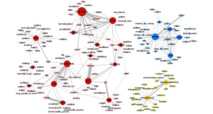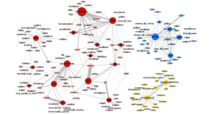
Semantic networks of English
The semantic networks generated by an international team of scientists with the vocabulary of 81 languages show that behind the concepts of the words and the relations that are stablished between them, it seems that there is a universal structure common to all languages, which does not depend on culture or geography, but on the human cognitive faculty.
Two of the multiple meanings of the word ‘sky’ in Spanish are the blue layer that surrounds the Earth and the place where angels and blessed dwell with God. In French (ciel), it happens something similar, but in English it exists a difference between the firmament (sky) and the paradise (heaven), although both concepts are strongly related.
According to Dail Software, echoing Tendencias 21, scientists from the Oxford University (United Kingdom) and other international centres have analysed this type of associations between words, gathered in cross-linguistic dictionaries. Their objective was determine if there are some universal properties common to human cognition which mark the structure of languages –as results seem to confirm–, or if language is a reflection of the culture or geographic region where it exists.
The authors, who publish their study in the journal PNAS, have designed a mathematical model and statistical tools to quantify the semantic similarity. Moreover, they selected terms related to materials (stone, ash, sand), celestial objects (sun, moon, star), units of time (day, night) and geographic characteristics (mountain, river, lake) which may be very influenced by the environment where the language may have developed.
By examining polysemic words –those that have multiple meanings– in each language, and how these are related to each other, scientists created maps of semantic networks. Each concept is represented by a node, which can be connected to others so that the size of the nodes and their links are proportional to the number of connexions.
Associations
Data reflect that some words present meanings and relations typical of a language, such as ‘sun’, which is associated with ‘divinity’ or ‘time’ in Japanese, but with ‘thirst’ or ‘day’ in the African language ǃXóõ. However, in spite of these particular issues, the semantic networks allow authors to generalise and detect statistical tendencies that show how human languages ‘have a common structure which underlines the meaning of the words, and which is independent of culture and geography.’
For example, words such as ‘sky’/ ‘heaven’ or ‘Earth’/ ‘soil’ tend to be polysemic in multiple languages. The same occurs with connections between their meanings. In most languages words such as ‘sea’ or ‘salt’ are related to each other in a very closely way with the two meanings of ‘sun’.
Two of the multiple meanings of the word ‘sky’ in Spanish are the blue layer that surrounds the Earth and the place where angels and blessed dwell with God. In French (ciel), it happens something similar, but in English it exists a difference between the firmament (sky) and the paradise (heaven), although both concepts are strongly related.
According to Dail Software, echoing Tendencias 21, scientists from the Oxford University (United Kingdom) and other international centres have analysed this type of associations between words, gathered in cross-linguistic dictionaries. Their objective was determine if there are some universal properties common to human cognition which mark the structure of languages –as results seem to confirm–, or if language is a reflection of the culture or geographic region where it exists.
The authors, who publish their study in the journal PNAS, have designed a mathematical model and statistical tools to quantify the semantic similarity. Moreover, they selected terms related to materials (stone, ash, sand), celestial objects (sun, moon, star), units of time (day, night) and geographic characteristics (mountain, river, lake) which may be very influenced by the environment where the language may have developed.
By examining polysemic words –those that have multiple meanings– in each language, and how these are related to each other, scientists created maps of semantic networks. Each concept is represented by a node, which can be connected to others so that the size of the nodes and their links are proportional to the number of connexions.
Associations
Data reflect that some words present meanings and relations typical of a language, such as ‘sun’, which is associated with ‘divinity’ or ‘time’ in Japanese, but with ‘thirst’ or ‘day’ in the African language ǃXóõ. However, in spite of these particular issues, the semantic networks allow authors to generalise and detect statistical tendencies that show how human languages ‘have a common structure which underlines the meaning of the words, and which is independent of culture and geography.’
For example, words such as ‘sky’/ ‘heaven’ or ‘Earth’/ ‘soil’ tend to be polysemic in multiple languages. The same occurs with connections between their meanings. In most languages words such as ‘sea’ or ‘salt’ are related to each other in a very closely way with the two meanings of ‘sun’.


 English
English



